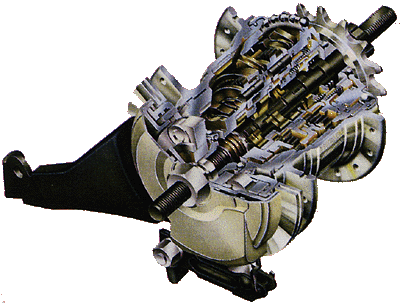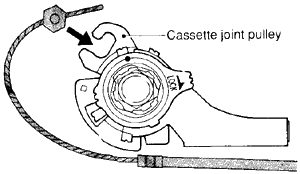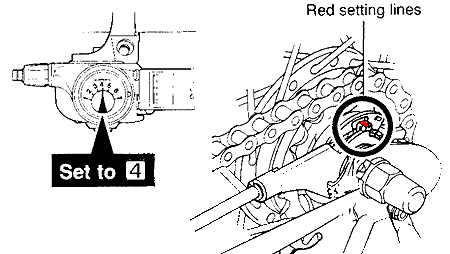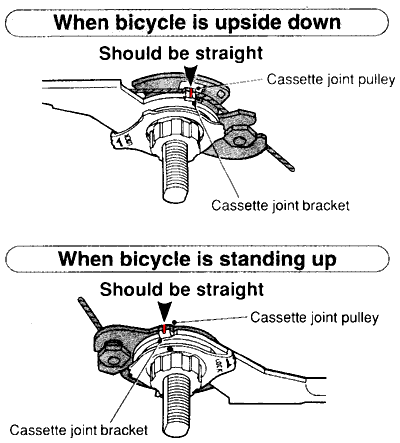
|


|


This article gathers information common to many models of Shimano internal-gear hubs. Information about specific models is in the articles about
The 5-speed is covered in the Nexus dealer's manual, linked below.
There are also articles on this site more generally about
Shimano Nexus 3, 4, 5, 7 and 8-speed hubs are currently in production as of 2024. Alfine is a high-end product line with 8 and 11-speed hubs. Nexus and Alfine 8-speed hubs are nearly identical internally.
Shimano published a Nexus dealer's manual (now archived), with most of the needed information about Nexus 5, 7 and 8-speed hubs; however, there is additional information in documents (some also now in the Internet Archive) linked below and on the pages on this site for individual hub types..
Nexus 7 and 8-speed hubs have an overlocknut spacing ranging from 127 to 135 mm, as sold: see Shimano's overlocknut spacing chart. Additional spacers can take hubs out to 135 mm. Some of these hubs have a coaster brake, and others accept the Shimano Rollerbrake, a kind of drum brake. If there is no Rollerbrake installed, the overlocknut spacing can be smaller, down to about 124 mm, using a thinner locknut. See our Rollerbrake page for information on installing and removing the Rollerbrake. Alfine hubs have an overlocknut spacing of 135 mm and a Shimano CenterLock disc-brake fitting. (One Nexus hub also hast this.)
Shimano sells cable-operated shifters for these hubs only for flat handlebars, but aftermarket (JTek, Microshift) shifters and a Hubbub adapter are available to fit drop bars. Some 8- and 11- speed models have electrical ("Di2") shifting. Electrical shifters work with drop bars or flat bars.
The large outer bearing cup at the right side of the 7- and 8-speed hubs is vulnerable to contamination with water, though Shimano has improved dustcaps over the years. If the bearing cup becomes pitted, you could: replace the hub shell -- then it is usually most practical to replace the entire wheel. Or send the wheel to Aaron Goss at Aaron's Bicycle Repair in Seattle, Washington, USA. He has tools to extract the bearing race, resurface it and replace it.
Except for the Alfine 11-speed, these hubs are grease-lubricated. Relubrication using oil and waterproof grease, event with a new hub, is highly recommended to keep water out of the mechanism. There is specific advice elsewhere on this page. Coaster brakes, however, must be lubricated with a special high-temperature grease. Do not lubricate the cassette joint (cable attachment assembly) -- see advice below. The page covering the 11-speed gives more detail about lubrication of this hub.
I have drilled and tapped a Nexus 8-speed for a Sturmey-Archer oil cap. A reader, Albert van Dalen, suggests a simpler solution: drilling an oil hole in the hub shell and covering it with duct tape. See his Web page for advice.
![]()
![]()
Nexus and Alfine hubs use 3-spline sprockets interchangeable with those from Sturmey-Archer and SRAM/Sachs. Alfine sprockets include a protector ring which helps to prevent a loose chain from coming off. This is especially helpful if the hub is used with vertical dropouts and a chain tensioner.
These sprockets are readily available in a range of sizes from 13-24 teeth. Older sprockets all use 1/8" (track) chain; many newer ones can use narrow chain, but they The Nexus and Alfine hubs cannot use ones smaller than 16 teeth, at least not with 1/8" chain, due to interference. By changing the sprocket, you can raise or lower all of the gears at once.
Because the shifter mechanism is between the right-side dropout and the sprocket, the chainline is desirably narrow in spite of the large overlocknut spacing of these hubs.
More detailed infromation about sprockets is in our article on internal-gear hubs.
Gates carbon-fiber belt drive also is available for some Nexus and Alfine hubs.
The Shimano CenterLock fitting of Alfine hubs accepts a proprietary Shimano disc brake rotor. The rotor diameter is 180mm, not the usual 185mm, raising issues of compatibility with non-Shimano caliper assemblies. The rotor is held in place by a lockring different from the one for Shimano cassettes, but it can be installed and removed using the same tool, unless it is the tool with a pin to insert into a hollow axle. Several brands of adapters for common 6-bolt rotors are available. Or you can leave the rotor off, install the supplied cover for the CenterLock fitting, and use a rim brake.
Nexus 3, 4, 7- and 8-speed internal gear systems may incorporate all-weather braking systems. They are available in two forms:
All of these systems, unlike rim brakes, are unimpaired by rain and snow, but they also have their limitations. A coaster brake can easily skid the rear wheel, but is hard to control and overheats on long downhill runs. A Rollerbrake is easier to control but also may overheat, and imposes a light but constant drag. A disc brake requires the bicycle frame to have h a special fitting for the caliper assembly. See the separate articles on this site about disc brakes, coaster brakes and Rollerbrakes.
Most Nexus 3-speed hubs are shifted using a bellcrank and pushrod, as described in the article about the 3-speed hubs.
Most Nexus and Alfine hubs with 4 or more speeds, and some 3-speeds, use a "cassette joint" which includes a pulley between the right dropout and the sprocket, concentric with the axle. This protected location moves the sprocket inboard, resulting in a conservative chainline despite these hubs' large overlocknut dimensions.Electrical ("Di2") shifting, uses a motor unit between the right-side dropout and sprocket.
Cassette joint parts are the same for the 4- and 7-speed hubs; different for the 5 and 8-speed hubs; different again for the 11-speed hubs. See this document describing differences.
The photo below shows cassette joint parts for a 5 or 8-speed hub, from left to right, the driver cap, cassette joint and cassette joint fixing ring. The 11-speed hub also uses a driver cap; the 3, 4 and 7-speed hubs use none.
Do not lubricate the cassette joint. That makes it collect dirt and stick. The two parts easily pop apart for cleaning. No need to remove the little screws. Just gently pull. That makes it easy to clean the inside of the adjustment mark view window. (Thanks to Aaron Goss for this info!)
With most of the hubs which use a cassette joint, the cable is tightest in top gear; the 11-speed hubs and the SG-7000 and SM-7000 8-speed Alfine hubs pull the cable tightest in the lowest gear. The cable engages the pulley at the top instead of the bottom with these hubs, and the cassette joint looks like the one in the picture below. Other than that, installation is similar to that of other cassette joints. The fixing ring turns clockwise to lock, same as with the others.
The cable-pull step for the newer Alfine hubs with reversed cable pull and the others are almsot the same, only their order is reversed -- as we discovered researching our cribsheet. A "wrong-way" shifter will probably work, the numbers will just read backwards. And you never have to look at it anyway. You'll find out the first time you shift.
The newer Alfine 8-speeds with the intended shifterswill work the same as for rear derailers (except "Rapid Rise"). If you use another bicycle with derailers. c you might hoose your shfiters to avoid conufsion.
The Alfine hub with cable entry above the hub axle, which releases the cable to upshift, is advantageous because you are less likely to catch a pawl halfway engaged, possibly causing damage. Because the cable releases to upshift, the hub can find its way to engage the higher gear rather than being forced to shift by the cable. When downshifting, the pawl for the new gear will be moving faster than one for the higher gear, and so it isn't going to get jammed.

The photos below show the steps in installation of the cassette joint on an 8-speed hub. Remove the cable before installing the cassette joint. Install the cassette joint, then install the cable before installing the wheel -- this is easiest -- or use an old spoke or small Allen wrench to rotate the cassette as shown below.
1. Sprocket and sprocket circlip are installed before the cassette joint parts. |
2. The driver cap snaps on, concave side down. |
3. The cassette joint is installed either of two ways, so the red dots line up. |
4. The cassette joint fixing ring is installed so the yellow dots line up. Turn it clockwise to lock it. |
The motor unit for a hub with electrical shifting is installed with both the hub and the motor unit in first-gear position. Dots at the right end of the hub should be aligned as shown. Shimano has a special tool to align them, but this can also be achieved with careful clockwise rotation of the two notches in the ring shown in gray, using an adjustable pin spanner.

The tabs in the motor unit should be aligned as shown in the next picture. If they are not, use the electrical shifter to shift the motor unit to first-gear position. There should be a rubber sealing ring just inside the indentation in the inner face of the motor unit. Install it if necessary. The smaller-diameter side faces inward.

The motor unit can install either of two ways. Either way is OK: you will rotate the axle when installing the wheel so the electrical connection faces forward. Place the motor unit over the end of the axle so that marks on it line up with marks on a spacer inboard of locknut B, as shown in the image below. Rotate the motor unit clockwise to engage it with the axle assembly, and install locknut B, which secures the motor unit. (Note: in at least one dealer manual, DM-S7051-02-ENG-1.pdf, labels for inner and outer locknuts are switched.) The legend for the drawing in the manual reads:
(A) Right-hand lock nut B
(B) Right-hand lock nut A
(C) Motor unit
Yow! Installation of this hub is already complicated enough! The labels are corrected in the image below.)

You can install the cable before installing the wheel in the dropouts or find the little hole in the cassette joint pulley where you insert a 2mm Allen wrench or bicycle spoke to rotate the cassette joint counterclockwise so you can install the cable.
These instructions are for cassette joints where the cable attaches below the hub axle. If it acches above, the cassette joint will have a handle to turn it clockwise.
Cassette joint rotated to allow insertion of cable





![]()
![]()
Adjustment is made with the shifter in 4th gear for the 4, 7- and 8-speed hubs, 6th gear for the 11-speed hub. On the right side of the hub, just outboard of the sprocket, there is the "cassette joint pulley" which the cable turns as the gears are changed. Next to this is the "cassette joint bracket" which is stationary. Both the pulley and the bracket have index marks, and gear adjustment is correct when the marks on the two parts align with the shifter in 4th gear (6th gear on the 11-speed).
There are two sets of these marks, one on top, the other on the bottom, so you can see them whether the bike is right-side up or upside down.
This procedure is the same for the Nexus 4-, 7- and 8-speed hubs, using 4th gear as the reference. With the 8-speed, however, the marks you need to line up are yellow, not red.





Internal-gear hubs always require some system to prevent the axle from rotating, as it is used as part of the gear train. As with most other internal gear systems, Shimano uses tab washers that engage the dropout slots to keep the axle from turning.
The axle flats and washer tab are not in line with each other, as with Sturmey-Archer and Sachs/SRAM hubs, and so you may have to file the dropout slots of an older bicycle to fit a Nexus hub. File only the lower edge of the dropout slots, to avoid disturbing wheel alignment. You may check your work using an anti-rotation washer: if the tab of the washer fits, the axle will fit. Except with vertical dropouts, the tab should preferably face the closed end of the dropout slot, for better engagement.
Because the shift cable linkage ("cassette joint unit" in Shimano-speak) is also keyed to the axle, different anti-rotation washers work with different dropout angles. You need to select washers for your particular frame.
(Earlier Nexus hubs only used an anti-rotation washer on the right side, but newer models use a pair of them, each a mirror image of the other.)
The 5R and 7L are nearly identical, as are the 5L and 7R, and so these pairs may be interchanged by switching sides. The 6R and 6L also may be used on the "wrong" sides of the hub for the best cable alignment with some bicycles. The 8L and 8R may be useful with forward-facing dropouts if you would like to run the cable up a seatstay.
The washers are color coded as shown in the chart.
Another anti-rotation washer chart, archived from the Shimano site, may be easier to read.
The Nexus hubs were not originally intended for use with bikes that have vertical dropouts. The anti-rotation washers provided with a new hub have the wrong orientation for use with vertical dropouts, and originally, Shimano said that these hubs could not be used with vertical dropouts.
Shimano has reconsidered, however, and now makes available an optional set of anti-rotation washers that work with vertical dropouts. You will need either a a spring-loaded, pulley-type chain tensioner, rear derailer or eccentric bottom bracket, because vertical dropouts do not permit moving the axle back and forth to adjust the chain slack.
Note, only the eccentric bottom bracket, not the chain tensioner or rear derailer, will work with the coaster brake version of the Nexus hub, because backpedaling places the lower run of the chain under high tension.
![]()
![]()
I have a very nice 1970's Raleigh Competition racing frame which I converted into a Nexus 7-speed:
Sheldon Brown's Nexus Raleigh Competition
That worked out so nicely that I converted my early '70s Raleigh International, using a Nexus 8-speed.
I like the Nexus 8-speed a lot better than the 7-speed version.
Sheldon Brown's Nexus Raleigh International
Ideally, the frame should have a dropout spacing of 127 to 135 mm to fit one of the Nexus hubs. Older bicycles are typically narrower than that. In the case of steel (Cromoly) frames, it is usually possible to spread the rear triangle to the needed width. Any good bicycle mechanic will be able to do this, or you can do it yourself.
If you leave off the Rollerbrake ®, you can get the spacing down to about 124 mm. This is what I did on my Nexus bike. The Rollerbrake ® is a separate module, and when you buy the hub it is not even installed. (The brake unit would get in the way of fitting the spokes through the hub flange, so it has to be installed after the wheel has been built.)
![]()
![]()
 The Alfine 11-speed is oil-lubricated, but the other Nexus and Alfine hubs are packed with a special grease as sold. Mechanical problems can result from "preventive maintenance" including re-lubrication with incorrect grease. This is especially the case if a hub has a coaster brake, due to the heat this brake generates.
The Alfine 11-speed is oil-lubricated, but the other Nexus and Alfine hubs are packed with a special grease as sold. Mechanical problems can result from "preventive maintenance" including re-lubrication with incorrect grease. This is especially the case if a hub has a coaster brake, due to the heat this brake generates.
Metal wear particles contaminate the grease, and so the hubs require periodic cleaning and replenishment of a special grease that does not make the pawls stick. The hub must be disassembled into its major components, solvent cleaned, dried and re-lubricated. Still, frequent failures of grease-lubricated hubs due to water contamination have been reported in wet climates --see photos here. Oil lubrication, with waterproof grease for the outer bearings, avoids this problem and also allows replenishment of the lubricant without dismantling the hub.
Information about converting to oil lubrication is in the main file about internal-gear hubs.
Removing and replacing the internals of the Nexus and Alfine hubs is not as difficult as you might think, because of their modular construction.
If you unscrew everything that is screwed onto the left end of the axle, the whole mechanism can be pulled out of the right side as a unit.
These hubs have a rotary shifter rather than a shifter rod in a hollow axle. To replenish oil between rebuilds, you must either unscrew the left bearing cone (which requires removing the wheel from the bicycle) or else add an oiling port, such as a Sturmey-Archer oil cap.
A Shimano Rollerbrake is lubricated without any disassembly, using the special Nexus brake grease -- there's a small rubber access plug on the side of the brake unit, just pop off the plug, put the nozzle of the grease tube up against it, and squeeze. Do not use Rollerbrake grease for anything else. It contains abrasive particles.
![]()

Shimano technical information pages |
|---|
Shimano Tech Tips -- older pages: structure and function, troubleshooting charts etc. |
Rollerbrakes |
Aaron's Bicycle Repair, Seattle, Washington, USA -- specializes in internal hubs |
![]()
![]()